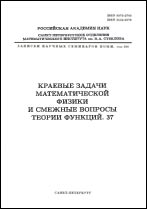|
|
Zapiski Nauchnykh Seminarov POMI, 2022, Volume 516, Pages 69–120
(Mi znsl7270)
|
 |
|
 |
This article is cited in 2 scientific papers (total in 2 papers)
On characteristic determinants of boundary value problems for Dirac type systems
A. Lunev, M. Malamud
Nikol'skii Mathematical Institute of Peoples' Friendship University of Russia, Moscow
Abstract:
The paper is concerned with the asymptotic behavior of the eigenvalues of the following $n \times n$ Dirac type equation
$$ y' + Q(x) y = i \lambda B(x) y, y = \mathrm{col}\,(y_1, \ldots, y_n), x \in [0,\ell], $$
on a finite interval $[0,\ell]$ subject to general regular boundary conditions $C y(0) + D y(\ell) = 1$ with $C, D \in \mathbb{C}^{n \times n}$. Here $Q = (Q_{jk})_{j,k=1}^n$ is an integrable potential matrix and $ B = \mathrm{diag}\,(\beta_1, \ldots, \beta_n) = B^* \in L^1([0,\ell];\mathbb{R}^{n \times n}) $ is a diagonal matrix “weight”. If $n=2m$ and $ B(x) = \mathrm{diag}\,(-I_m, I_m) $ this equation is equivalent to $n\times n$ Dirac equation.
Under the assumption $\mathrm{supp}\,(Q_{jk}) \subset \mathrm{supp}\,(\beta_k - \beta_j)$, we show that the deviation of the characteristic determinants $\Delta_Q(\cdot)$ and $\Delta_0(\cdot)$ of this boundary value problem (BVP) and the unperturbed BVP (with $Q \equiv 0$) is a Fourier transform of some integrable function,
$$ \Delta_Q(\lambda) = \Delta_0(\lambda) + \int\limits_{\widetilde{b}_-}^{\widetilde{b}_+} g(u) e^{i \lambda u} du, g \in L^1[\widetilde{b}_-, \widetilde{b}_+]. $$
We apply this representation to study of zeros distribution of the characteristic determinant $\Delta_Q(\cdot)$ (eigenvalues of the above BPV) and show that $\Delta_Q(\cdot)$ is always an entire class $A$ function of exponential type, which is bounded on the real axis. We also find conditions guaranteeing that $\Delta_Q(\cdot)$ is a sine-type function and provide sharp asymptotic formula for its zeros.
Finally, we show that if the entries of matrix $B(\cdot)$ can change sign within the segment $[0,\ell]$, then in general even in the case of regular boundary conditions eigenvalues split into two branches: the “good” branch lies in the horizontal strip and is close to the eigenvalues of the unperturbed BVP, while the “bad” branch has non-zero density and imaginary parts that tend to infinity. We illustrate this effect on a concrete $2 \times 2$ example.
Key words and phrases:
systems of ordinary differential equations, regular boundary conditions, sine-type functions, eigenvalues asymptotic.
Received: 04.11.2022
Citation:
A. Lunev, M. Malamud, “On characteristic determinants of boundary value problems for Dirac type systems”, Mathematical problems in the theory of wave propagation. Part 52, Zap. Nauchn. Sem. POMI, 516, POMI, St. Petersburg, 2022, 69–120
Linking options:
https://www.mathnet.ru/eng/znsl7270 https://www.mathnet.ru/eng/znsl/v516/p69
|

| Statistics & downloads: |
| Abstract page: | 115 | | Full-text PDF : | 47 | | References: | 29 |
|




 Contact us:
Contact us: Terms of Use
Terms of Use
 Registration to the website
Registration to the website Logotypes
Logotypes








 Citation in format
Citation in format 
